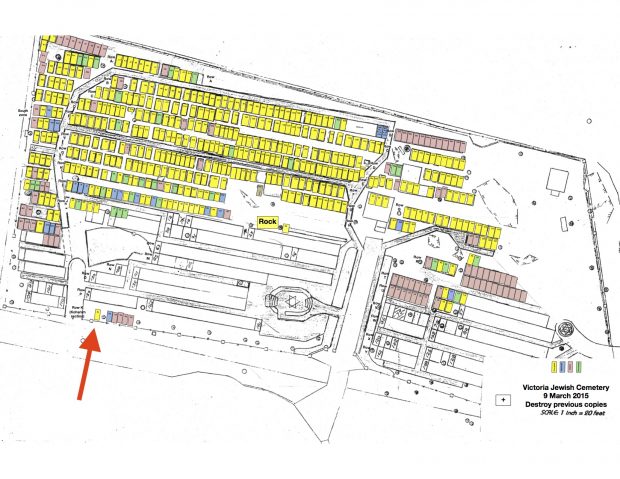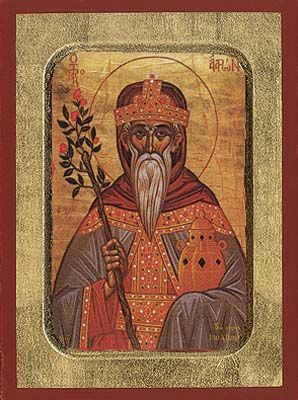Last week we arrived at the cemetery and while waiting for our morning meeting our group noticed a lone grave, away from all the rest, against the front fence of the cemetery. We made a note to ask about it later, but our question was answered during a tour by Dr. Rick Kool. Dr. Kool had arrived that day to give us some more history about the cemetery. He explained that for those who strictly observe Orthodox traditions, the kohanim, or high priests, are not supposed to enter cemeteries. Instead, to visit a deceased loved one, kohanim graves may be placed near the fence.

Map of the Victoria Jewish Cemetery showing the plots by the fence. The plot that is marked in yellow are occupied while the others are either reserved or remain open. Photo courtesy of Anthropology 367 coursespaces page.
If you research kohanim (plural of kohen) many articles are about genes and DNA (Zoossmann-Diskin, 2006). This is because being a kohen is all about lineage. Zoossmann-Diskin explains that within the Jewish community there are tribes making up 3 groups: Kohanim (descendants of high priests), Levites (descendants of priests’ helpers) and Israelites (lay people). These lineages can often be

Aaron, the high priest. Kohanim are descendants from his lineage. Photo taken from www.athineon.com.
identified by surnames. Kohanim will have a strong “c” or “k” names including Cohen, Katz, Kogan. According to Chabad.org, they are descendants of Aaron, who was Moses’ brother from the Old Testament. Aaron was a high priest, which means his descendants are as well. As per tradition, only men can be kohen and the status of such comes from the paternal side. Daughters of kohanim also have special privileges and obligations but usually only until she is married. MyJewishLearning.com states if you were born a kohen, then according to orthodox Judaism, there are strict rules to follow. The kohanim are thought to be from an elevated spiritual level, which prohibits them from being in contact with dead bodies. Encountering dead bodies, or even being under the same roof as one, may convert the kohen to tamei (impure). Even their children have to be cared for in a way that does not make them tamei.
Therefore, as you approach Jewish cemeteries, you will notice how close some graves are to the fence. Kohanim must stay at least six feet away from dead bodies and are not even permitted to be under the same roof as where dead bodies are present. This makes visits to hospitals, museums, and funerary chapels tricky, since they may have dead bodies. If a kohen needs to visit any of those places, they must consult their Rabbi, who will assess the reason. There are exceptions to the rule, which applies to a tzaddikim body; the body of a righteous person. In this case, contact with a body may be permitted.

The kohanim blessing hand symbol represents the first letter, shin, of the Hebrew work “Shaddai” which means Lord. “Shaddai” is taken from the first three letters of the phrase “Guardian of the doors of Israel”. Photo courtesy of www.hebrew4christians.com.
Kohanim graves are also special in that they may bear a symbol well-known to the average population. An aspect of kohanim symbolism that has made its way into pop culture is the “Vulcan salute” of Star Trek fame. It is reported from Quartz that Leonard Nimoy used one half of a kohanim blessing as a salute. Traditionally the kohanim, or high priest, would bless the congregation by hold both hands up, thumbs stretched and the middle and ring fingers parted to form a sort of V. The shape, altogether, was meant to form shin, the first letter of Shaddai, meaning “Lord.” Shaddai in Hebrew is the first 3 letters taken from the Hebrew phrase “guardian of the doors of Israel”. Nimoy recalls seeing the blessing as a child, and it left a powerful impression on him. He decided, when meeting other Vulcans on Star Trek for the first time, he needed a powerful symbol or greeting, and used the now famous hand symbol he remembered from his childhood. Within Emanu-el cemetery, there are some kohanim graves that have chosen to include this blessing as a part of their monument. While the cemetery is not strictly orthodox, many still wish to express some aspect of their tribe’s lineage on their gravestone.

Kohanim blessing found on gravestones and Leonard Nimoy using the symbol as his character Spock in Star Trek. Left photo from www.jewishcemetery.sk and middle photo from www.startrek.com. Right photo taken by Danielle at Emanu-el cemetery.